

Jews in Pre-War Germany. (January 22-23, 1934) : Table of Contents | Introductory History | Glossary of Terms ...The full truth about the persecution of the Jews is not and cannot be known.
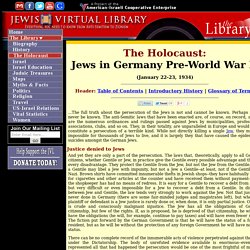
Perhaps it will never be known. The anti-Semitic laws that have been enacted are, of course, on record, and so are the numerous ordinances and rulings passed against Jews by municipalities, professional associations, clubs, and so on. They, in their totality, are unparalleled in Europe and would alone constitute a persecution of a terrible kind. Justice denied to Jews And yet they are only a part of the persecution. There can be no complete record of the innumerable acts of violence perpetrated against the Jews under the Dictatorship. Maltreatment The persecution also varies in severity from district to district. German Jews during the Holocaust, 1939–1945. 1933-1939 In January 1933, some 522,000 Jews by religious definition lived in Germany.
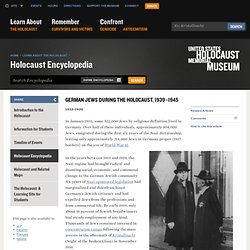
United States Holocaust Memorial Museum. Holocaust Memorials and Public Memory - Historic Sites - Amsterdam. Jewish Life in the Netherlands "The great Jewish presence in the Netherlands began and ended in tragedy.
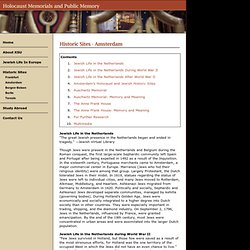
" —Jewish Virtual Library Though Jews were present in the Netherlands and Belgium during the Roman conquest, the first large-scale Sephardic community left Spain and Portugal after being expelled in 1492 as a result of the Inquisition. In the sixteenth century, Portuguese merchants came to Amsterdam, a major commercial center in Europe. Marranos (Jews who hid their religious identity) were among that group.
Martin O’Neill meets Bettine Le Beau. Bettine’s mother agreed that Bettine and her brother should be smuggled out and taken to an OSE home for rescued children near Limoges.

Bettine recalls being very lonely at the children’s home – she was lice-ridden from the camp and wet the bed because she was frightened and alone. She longed to go back to Gurs where she had friends and was near to her mother, in spite of the awful conditions there. In 1941, the hope of escape was awakened by the possibility of boarding a boat from Marseilles to America, where Bettine had family who had already fled. On the day they were scheduled to embark, America entered the war on the side of the Allies, scuppering their chances of escaping from France. Bettine credits OSE with saving her life. Voices of the Holocaust. During the 1930s and 40s, the Nazis and their collaborators murdered six million Jews.

Hitler's intention was to destroy all Jewish communities, and to build a 'master race' of Aryans. Many other 'non-aryans' were persecuted including Romanies, homosexuals, and the disabled, as well as those who were politically opposed to the Nazis. This terrible moment in history is now known as the Holocaust. Alicia Appleman-Jurman: Survival and Heroism of a Young Girl During the Holocaust. German-Jewish History Online. Women in the Holocaust. While women’s experiences during the Holocaust were not entirely different from those of men, it would be false and misleading to assert that they were identical.
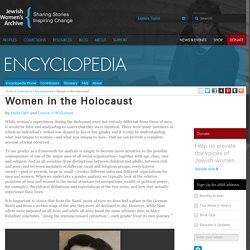
There were many instances in which an individual’s ordeal was shaped by his or her gender and it is only by understanding what was unique to women—and what was unique to men—that we can provide a complete account of what occurred. To use gender as a framework for analysis is simply to become more attentive to the possible consequences of one of the major axes of all social organization—together with age, class, race and religion. Just as all societies draw distinctions between children and adults, between rich and poor, and between members of different racial and religious groups, every known society—past or present, large or small—creates different roles and different expectations for men and women.
We identify and discuss four sources of gender differences during the Holocaust: a. B. C. 70 Voices. Holocaust Timeline: Resistance. Holocaust Memorial Day Trust. 10 Incredible Cases Of Jewish Resistance During The Holocaust. History Though most Western depictions of World War II focus on soldiers rescuing helpless victims from German oppression, the truth is very different.

The human species doesn’t take kindly to genocide or oppression, and the Jews are no exception. 10 The Treblinka Rebellion 1943 About 800,000 to one million people were murdered at Treblinka Death Camp from July 23, 1942 to October 19, 1943 in Eastern Poland; 90 percent of all prisoners were murdered within two hours of arrival. The bodies were then taken by Sonderkommandos to the open cremation pit on a hilltop. The White Rose - A Lesson in Dissent. During the Holocaust, millions of Jews boarded rail cars and trains destined for the unknown.
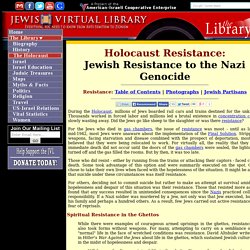
Thousands worked in forced labor and millions led a brutal existence in concentration camps, slowly wasting away. The Danish Center for Holocaust and Genocide Studies. Concentration camps and extermination camps belonged to two widely different camp systems: Extermination camps were only constructed with one purpose: to mass murder Jews and other “unwanted”.
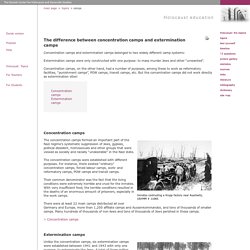
Concentration camps, on the other hand, had a number of purposes, among these to work as reformatory facilities, “punishment camps”, POW camps, transit camps, etc. But the concentration camps did not work directly as extermination sites! Unlike the concentration camps, six extermination camps were established between 1941 and 1943 with only one purpose: to exterminate the Jews. A total of three million Jews were murdered in these camps.